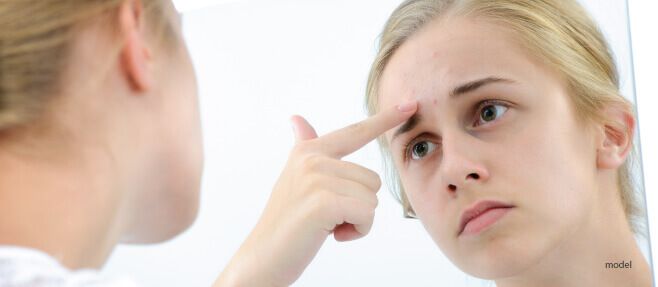Treating Hormonal Acne Without Birth Control

Are you frustrated that you’re still dealing with acne well past your teenage years? You’re not alone. A significant amount of women experience breakouts well in their 40’s.
While inflammation and bacteria (P. acnes) are the two main culprits of acne for many women, hormones are the underlying trigger for breakouts. Specifically, androgen receptors in women tend to be particularly sensitive leading to excess oil production creating a perfect environment for bacteria.
Is Your Acne Hormonal?
The easiest way to determine if your acne stems from hormonal influences is by paying close attention to the timing and locations of your breakouts. Your acne is most likely hormonal if your acne usually occurs shortly before or during your period and breakouts are centered on your lower face and neck. Pay careful attention to your breakouts over the next couple of months, even document occurrences if necessary. Realizing your breakouts stem from hormonal influences can be very helpful in determining treatment options.
Treating Hormonal Acne
The most common prescription treatment for hormonal acne is birth control pills. Birth control contains progesterone and estrogen to lower the number of androgens produced by your body. This prevents excess oil production and keeps the blemishes at bay. An alternative to birth control is an oral medication called spironolactone. It works by blocking the effects of testosterone also decreasing oil production. If one wants to avoid taking pills, the following alternate methods can help significantly with hormonal acne.
- Mild Cleansing: Properly wash your face with a gentle cleanser twice daily to keep the pores clear of dirt, excess oil, and makeup. We sell great cleansers like Caliderma Pumice Cleanser.
- Topical Acne Treatments: There are many over-the-counter options available in the drugstore and at your dermatologist’s office as well as prescription topicals for more stubborn acne.
- Chemical Peels: Glycolic or alpha hydroxyl acids (AHA) containing chemical peels can help remove dead skin cells that commonly clog pores contributing to breakouts.
- Healthy Diet: Eating a balanced diet that is high in skin healthy vitamins and drinking lots of water (aim for at least ten 8oz glasses of water daily) can have a great impact on minimizing breakouts. Also try to limit high glycemic index foods such as white bread and pasta as sporadic glycemic changes within the body can result in dramatic hormonal fluctuation.
- Sun Protection: Use a good sunscreen to minimize the pigment changes caused by older breakouts. EltaMD UV Clear is particularly effective because it contains niacinamide, a B3 vitamin that can help with breakouts, pigment, and redness.
- Exercise: Regular exercise can boost blood circulation throughout the body, which can help minimize skin inflammation.
- Stress less: Reducing daily stress can directly reduce your breakouts. Try practicing stress coping techniques like exercise, massage, yoga, or meditation.
Disclaimer: The contents of the Westlake Dermatology website, including text, graphics, and images, are for informational purposes only and are not intended to substitute for direct medical advice from your physician or other qualified professional.

Do y’all offer telemedicine?
Hi Sophia,
We do offer telehealth appointments. For more information please visit this page: https://www.westlakedermatology.com/resources/telehealth
Thanks,
WD Staff